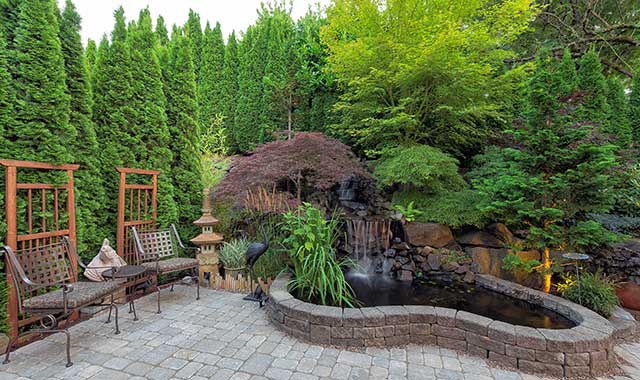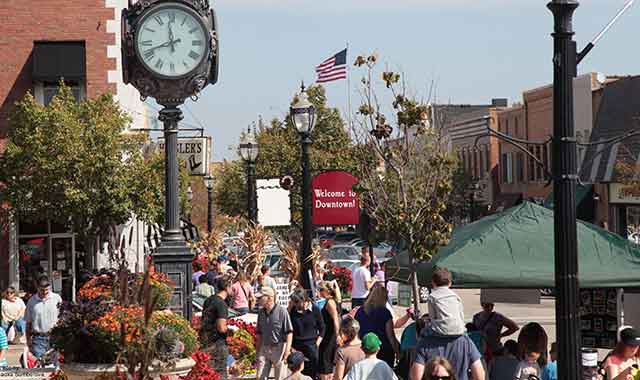There was a time when only the softscape — plant material — really mattered in landscaping. But now, you’ll find a good mixing of plant material and hardscaping — that is, heavy elements that add structure and function.

Years ago, nurseries and garden centers had one main focus: softscapes, better known as the trees, bushes and smaller plants that make yards look beautiful.
But today, those same companies have expanded their trade to offer not only the greenery that customers so desire, but also the hardscapes – the stones, patios, outdoor kitchens and other heavier elements that add structure and functionality.
“It’s become a part of the overall landscape,” says Sean Ducey, manager of Whispering Hills Garden and Landscape Center in Crystal Lake. “It used to be where you did just a little stone patio and lots of plants. Now, it’s the other way around.”
Ducey believes a complete landscape incorporates both softscapes and hardscapes, because such combinations are easily found in nature.
“Good landscapes bring people closer to nature, so it makes sense to bring patios and hardscape elements to the landscape,” he says.
How much hardscaping you use is up to you.
“There are different solutions to using your outdoor space,” says Barbara Kindinger, a landscape designer who’s been with Countryside Flower Shop, Nursery, and Garden Center in Crystal Lake since 1980. “A paver patio isn’t always the solution. Sometimes it’s concrete or crushed gravel, which can be very European and very natural. Sometimes it’s just lawn. That has to do with people’s choices and how they’re using their space.”
While the client always has the final say about how much hardscaping – and what kind – they want in their yard, local designers have a few tips to help you find balance in your next landscape project.
Know Your Needs and Wants
Hardscaping, in general, is a bit of a luxury item, says Kindinger. Heavier materials generally cost more than plant materials.
Still, a little hardscaping can go a long way. For an average family of four, 350 to 400 square feet of patio space can comfortably fit an average-size table and four chairs, says John Strait, a landscape designer with Platt Hill Nursery, in Carpentersville.
If you plan to entertain a few more guests, you can extend your hardscape to include a fire pit area with seat walls – typically 18 inches tall – which can comfortably seat six people, Strait says. Such a project would require an additional 200 square feet.
Those seeking an even larger entertainment space can think about installing multiple lounging or dining areas. Ultimately, the possibilities are limitless.
“We’re seeing a trend of permanent fixtures – bars, grills, kitchens – things like that are definitely becoming very popular and therefore more affordable,” Ducey says.
More affordable doesn’t necessarily mean cheap, however. Strait says outdoor kitchens can cost anywhere from $15,000 to $30,000, depending on the size and scale of a project and whether you run plumbing or gas lines to it.
Water features, popular before the recession, are returning, says Kindinger, but in lower-maintenance forms.
“We’ve done everything from a very, very grand waterfall in Barrington to very modest, but fun, waterfalls that an average person can afford – someone who wants some sound but not necessarily open water,” Kindinger says.
Fire features, outdoor televisions and sound systems also could be incorporated into your hardscape project.
“You can go crazy,” Ducey says. “You can have almost everything outside that your home has on the inside.”
Find Balance
Sometimes the easiest way to incorporate hardscaping is to use natural rocks as decoration, says Ducey.
But if you choose to have more hardscaping, remember to create balance.
“Plants have to be utilized around the patio, otherwise it’s going to look like a parking lot,” Ducey says. “If you’re going to embrace nature and make a room outside, embrace the whole experience: include the flowering plants you enjoy.”
“It doesn’t take much,” Kindinger adds. “It can be some simple perennials to soften some hardscaping. It doesn’t have to be a huge amount of plant material. My clue always comes from the client and the style that they want. Modern chic doesn’t necessarily have a lot of plant material in it, but a cottage garden is totally different.”
Shrubs and ornamental trees provide visual layers that break up a flat hardscape. Perennials add pops of color – and you won’t have to replant them every year.
An ideal place for your softscape is against the house or a fence line, but try not to install smaller plants right up against those structures.
“Instead, bring it out 4 to 5 feet so you have room for bushes or a niche for trees,” Kindinger says.
Give careful consideration to blending colors and textures both in softscapes and hardscapes.
For example, on a seat wall around a fire pit, the first two levels of blocks could be a prairie color, topped off with a complementary color, says Strait from Platt Hill.
Designers also consider the architecture and building materials of the house. If a home features an accent stone, Strait tries to mirror that color and style of stone, “so it looks like it was all planned as one project,” he says.
Similarly, inspiration for balance and uniformity can come from within the home.
“If you’re sitting inside looking at your fireplace, it’s a particular type of stonework,” Kindinger says. “If you look outside and see similar stonework, that really pulls outdoors indoors and indoors outdoors.”
It’s also good to think of the big picture, which means looking outside of your own property lines.
Many older Chicago-area neighborhoods feature mature landscapes that were designed to have a cohesive look, instead of the patchwork look we’re accustomed to today, Strait says.
If there are particular trees in your neighborhood that have thrived and would fit well into your general landscape, it might not be a bad idea to incorporate the same or similar species into your yard.
“That way, it looks like one big park setting, instead of different properties,” Strait says.
Local ordinances may dictate how much hardscaping a homeowner can have. Some municipalities set limits because of concerns about effective drainage and runoff.
In fact, most communities encourage homeowners to hardscape no more than 50 percent of a property, Strait says. About 30 percent is the norm for most residential, quarter-acre properties – which strikes a good balance, whether or not it’s mandated.
Be Practical
When you’re choosing materials for your hardscape, know that functionality and aesthetics don’t always go hand-in-hand.
Your first priority should be selecting a material well suited to the space you’re trying to create.
Flagstone, for example, is a beautiful hardscape material, but because it’s an uneven stone, it’s not recommended for seating or walking surfaces, especially if you throw parties where women will be wearing heels, says Strait.
Instead, consider a more uniform patio material like concrete pavers, straight concrete or natural stone.
Natural stone provides a timeless look and is Ducey’s favorite hardscape material. It can be used in irregularly shaped pieces or in dimensionalized pieces for a clean-lined, monochromatic look.
If you want every inch of your patio to look exactly the same, concrete is your best option. It’s usually the most economical choice, but tends to crack over time.
Pavers offer longevity because they adapt well to changing conditions. During winter and spring thaws, they move up and down in tandem and come back to form a flat surface, Ducey says.
“Natural stone does that to an extent, but due to the size of the pieces, corners may pop up,” he says. “It’s not as consistent.”
Stamped concrete is another option. Since it usually mimics natural stone and pavers, Ducey prefers to use the real thing. Still, he understands economics are involved.
“With the variety of product lines that are out there today, we can always find something that works with a customer’s budget,” he says.
When designing your landscape, keep proportion in mind.
In a small yard, a huge outdoor fireplace may look like a monstrosity instead of a well-designed addition to your space, Strait says.
“We have to maintain some scale to the space, so we’re not just paving over the whole thing,” he adds.
Have Your Own Ideas
Designers love helping customers and providing ideas. But that doesn’t mean they want complete control of your project.
“What works best in the design process is the back-and-forth between the client and I,” Kindinger says. “I listen, I throw out ideas, and then things just click, whether it’s a patio or a type of tree they want. It’s harder when people say, ‘You just do whatever you want to,’ because they’re not going to like what I come up with. When they respond to my initial ideas and we tweak it back and forth … that’s when we know the project is going to go well and everybody’s going to be pleased.”
The key is to work with a designer who knows the correct questions to ask and understands the scope of the project, Kindinger says.
Before you start a project, think about these things:
• How many people should the space accommodate?
• What kind of furniture do you have – or want to purchase?
• Are you looking to add any special features, like seat walls, kitchen areas, fire pits or water features?
• What’s your budget?
Keep in mind that large landscaping projects can be phased in with smaller increments to avoid a huge, lump-sum investment, Ducey says.
Remember, too, that every job will bid differently. Just because your neighbor was able to place a small patio in his backyard for $12 a square foot, that doesn’t mean you’ll be able to do the same, Ducey says.
If workers have to travel further to your backyard, or if your yard has a narrow entrance so equipment can’t fit through and workers have to carry materials by hand, the job might cost more.
Expert landscaping crews bring a wealth of knowledge, experience and reliability, but some adept DIY homeowners prefer to do the work themselves. Ducey is only too glad to help them through the experience.
“A lot of customers come in and do quite large projects on their own,” he says. “It’s a lot of hard work, but anybody with the DIY spirit can do it, and we’re happy to help them figure out any of the projects they need to include to complete their job.”





















































